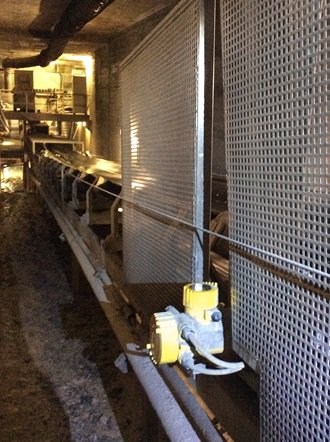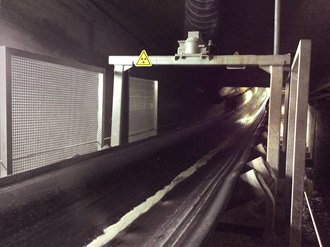Radiometric mass flow measurement ensures precision charging in lime works |
The Lhoist Group is a world leading company that specializes in burnt and unburnt lime products. Headquartered in Belgium, the company is present in 25 countries with more than 100 subsidiaries around the globe. Rheinkalk is the German company of the Lhoist Group. Their Flandersbach plant in Wülfrath is the largest plant of the Lhoist group and at the same time the largest lime works in Europe. Around 7.5 million tonnes of limestone are mined here every year.
Lime is known for its use as a flux in steelmaking processes. However, lime and limestone products are also an indispensable raw material in drinking water treatment, in sewage treatment plants, in construction and agriculture as well as in flue gas cleaning. The quality demands placed on the these products have grown steadily over the years. For example, even the grain size specified by the customer must be strictly adhered to. At the same time, delivery periods are getting shorter and shorter. These factors, as well as many others, make it necessary to measure the material quantities much more accurately than ever before.
It all begins with the extraction of limestone from the quarry. The limestone rocks are transported in mining trucks to a processing plant. There they are pre-crushed, washed, pre-sorted according to size and distributed to various storage areas. From there, the prepared material is further refined or fed to the burning (calcining) process. With the help of rotary and shaft kilns, the raw rock product is converted into a lime product. At the end of the production process, the fired products stand ready for a wide variety of applications.
Numerous conveyor belts with different lengths ranging from a few metres to one kilometre ensure that the rocks, which can be in a wide variety of different processing states, are transported to the right place for further processing. The ambient conditions in the plant are extremely harsh. Operating at speeds of up to approx. 4 m/s, the belts transport rocks with diameters of 0 - 250 mm. The delivery rate can be up to 4000 t/h. Precise measurement of this mass flow is required to control the feed to the downstream systems. This is accomplished by mechanical belt scales (dynamic belt weighing systems) installed on the conveyor belts. However, these devices are susceptible to dirt and dust and have to be checked and cleaned every few weeks, which entails considerable maintenance costs and interruptions to production.
Lime is known for its use as a flux in steelmaking processes. However, lime and limestone products are also an indispensable raw material in drinking water treatment, in sewage treatment plants, in construction and agriculture as well as in flue gas cleaning. The quality demands placed on the these products have grown steadily over the years. For example, even the grain size specified by the customer must be strictly adhered to. At the same time, delivery periods are getting shorter and shorter. These factors, as well as many others, make it necessary to measure the material quantities much more accurately than ever before.
It all begins with the extraction of limestone from the quarry. The limestone rocks are transported in mining trucks to a processing plant. There they are pre-crushed, washed, pre-sorted according to size and distributed to various storage areas. From there, the prepared material is further refined or fed to the burning (calcining) process. With the help of rotary and shaft kilns, the raw rock product is converted into a lime product. At the end of the production process, the fired products stand ready for a wide variety of applications.
Numerous conveyor belts with different lengths ranging from a few metres to one kilometre ensure that the rocks, which can be in a wide variety of different processing states, are transported to the right place for further processing. The ambient conditions in the plant are extremely harsh. Operating at speeds of up to approx. 4 m/s, the belts transport rocks with diameters of 0 - 250 mm. The delivery rate can be up to 4000 t/h. Precise measurement of this mass flow is required to control the feed to the downstream systems. This is accomplished by mechanical belt scales (dynamic belt weighing systems) installed on the conveyor belts. However, these devices are susceptible to dirt and dust and have to be checked and cleaned every few weeks, which entails considerable maintenance costs and interruptions to production.
A trial measurement delivers convincing results
WEIGHTRAC 31 can also be retrofitted to existing conveyor belts. Since it is a non-contact measuring device, wear is not a problem.
VEGA, a partner of Lhoist for over 20 years, first recommended setting up a trial measurement with the WEIGHTRAC 31 radiometric measuring system for mass flow determination on the conveyor belt. The system consists of a scintillation detector and a radioactive source safely enclosed in a source holder. A minimally radioactive isotope emits concentrated gamma rays, which penetrate the bulk material.
The receiver, which is mounted below the belt, picks up this radiation. Because gamma rays are attenuated when penetrating matter, the receiver can calculate the rate of mass flow from the intensity of the incoming radiation and the speed of the conveyor belt. Thanks to its frame construction, WEIGHTRAC 31 can be easily retrofitted on conveyor belts. In non-contact measurement, there are no problems with wear.
The receiver, which is mounted below the belt, picks up this radiation. Because gamma rays are attenuated when penetrating matter, the receiver can calculate the rate of mass flow from the intensity of the incoming radiation and the speed of the conveyor belt. Thanks to its frame construction, WEIGHTRAC 31 can be easily retrofitted on conveyor belts. In non-contact measurement, there are no problems with wear.
Due to the good collaboration between the two companies up to that point and the many years of successful application of various VEGA products, the responsible technician at Rheinkalk was immediately willing to give the radiometric method a try. To be on the safe side, Rheinkalk first tested the new measuring principle for several weeks. The results were convincing, so it was decided to leave it in place. In the meantime, three additional radiometric measuring systems from VEGA have been installed and a fifth and sixth will soon follow.
Products
Export this article
Download as PDFShare this article
Comments ({{comments.length}})
This article has no comments yet. Write the first one now!
{{getCommentAuthor(comment, "Anonymous")}} {{comment.timestamp | date : "dd.MM.yyyy HH:mm" }}
{{comment.comment}}
This field is mandatory
This field is mandatory
This field is mandatory
Invalid email address
This field is mandatory
Your comment must not contain any links or email addresses
This field is mandatory
Invalid captcha
untranslated: 'Blog_SendComment_Error'



